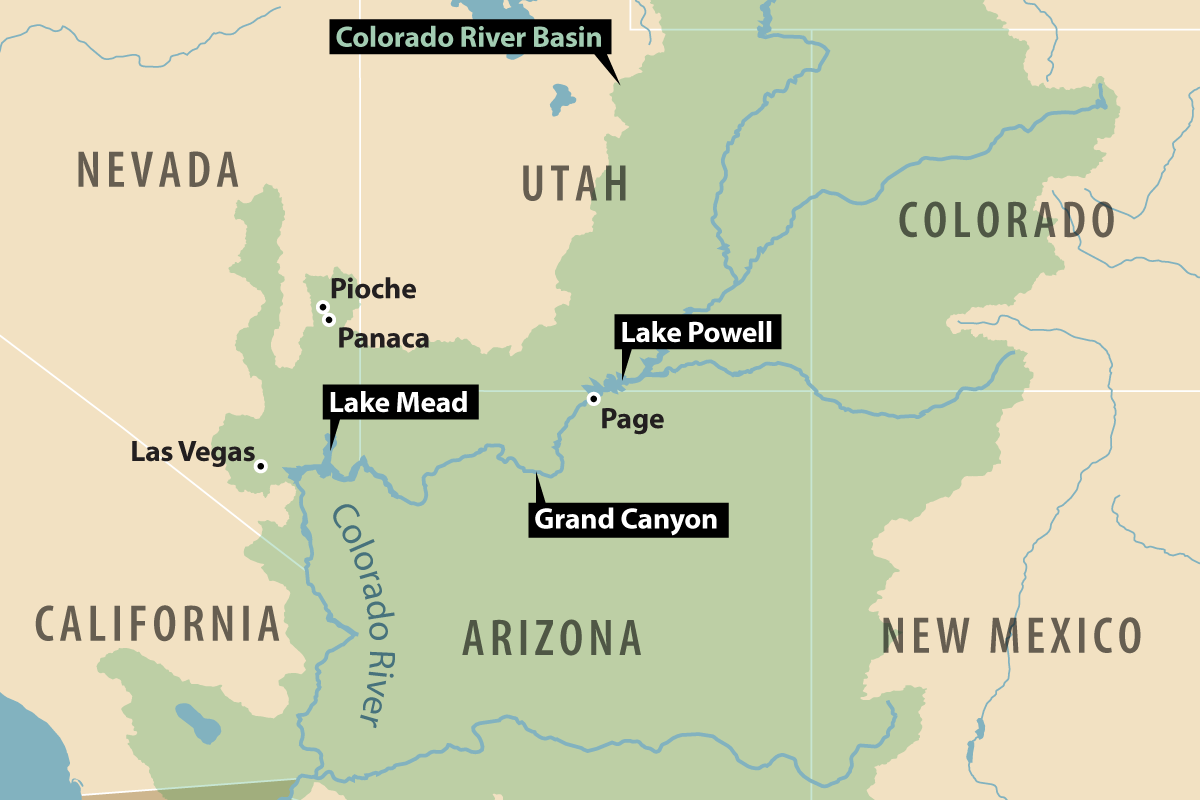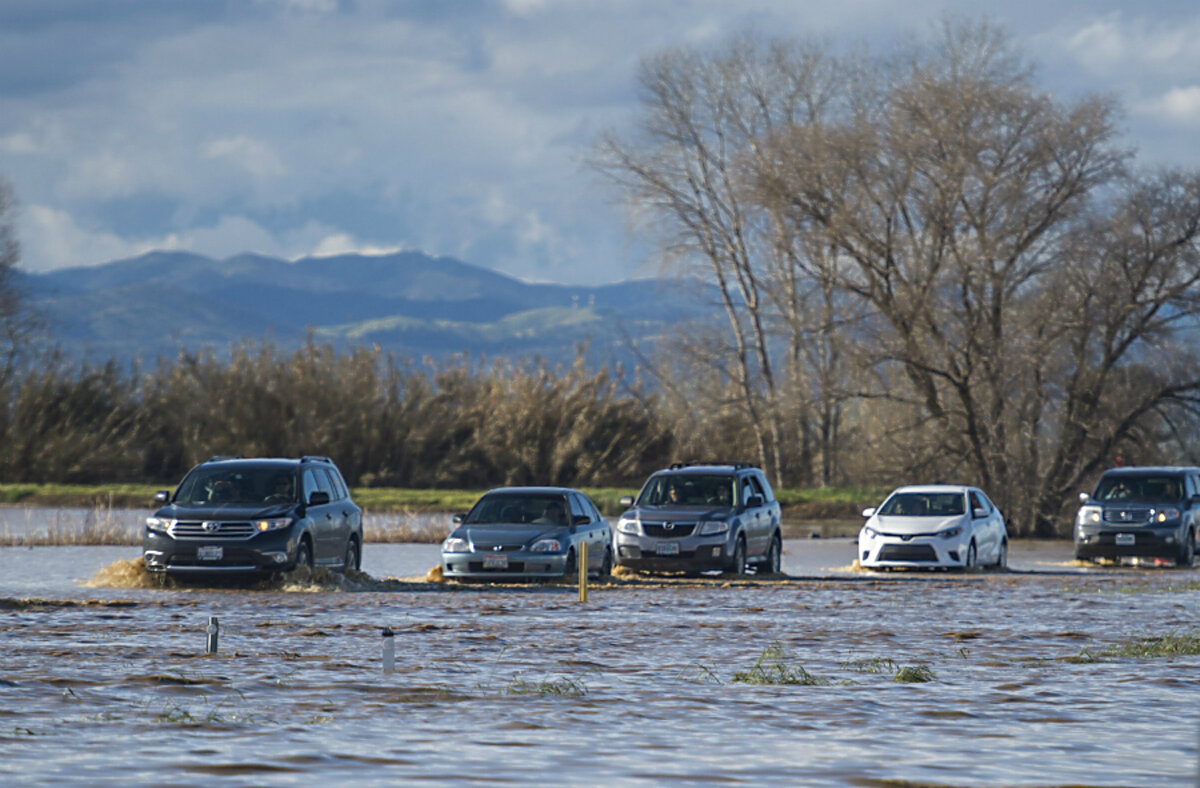West's challenge is still water scarcity, wet winter or not
Loading...
| Pioche, Nev.
The number of “For Sale” signs compete with “Open” in the storefronts along the main street in this hilly town, where fortunes evaporated with the silver and zinc mines that created it. There’s no bank or grocery store. Mining has mostly vacated the area, leaving a clutch of retirees, some county workers, and not too many others.
But this part of Nevada still has one resource that residents to the south in glitzy Las Vegas desperately want and need – water.
A controversial proposal would send a big chunk of this region’s water southward, through a 250-mile pipeline that, critics say, would dry up ranchers and farmers to supply a sprawling metropolis defined by its embrace of nightlife and all-day pool parties.
“The people in Clark County want to put a pipeline in here to drain our water. We don’t want to give it away to them. We do just fine up here,” says Don Spaulding, a retiree in Pioche.
But there’s a larger reality, too: Whatever happens with the pipeline, water has been getting harder to find for urban and rural residents alike. Even with big snows and rains across parts of the West this winter, aquifers and forests remain taxed. Long term, the water challenges of the American West look increasingly beyond the scale of traditional infrastructure projects to resolve.
Lake Mead, a major reservoir serving the Southwest, has recently been at record lows, pressuring Las Vegas to look for water sources outside the Colorado River system. And here in Pioche, residents say a long drought has taken its toll.
“We’re not getting as many tourists,” says Ann Mills inside her trinket shop called Rag Doll. “They come up for recreation, but even the lakes are low. Echo Lake gets really low. It’s not even good for fishing anymore. Eagle Valley is getting mossy and stinky.”
A new era of water management
Yet in the face of these challenges, residents of the West aren’t resigning themselves to a bleak future. Instead, states in the Colorado River basin have been turning a page toward a new era of water management. With climate change affecting water supplies that are already strained by urban growth, the region is being forced to innovate and adapt.
•Cities are conserving through steps like encouraging desert landscapes, by prohibiting grass lawns for newly built homes, and paying people with existing lawns to abandon them.
•Advancements in treatment technology are making it more possible to recycle water and harness rainfall for later use.
•Farmers are shifting to drip irrigation and other methods to use less water.
•Increasingly farmers are trading water through formal and informal markets to use it more efficiently, shifting away from a system of use-it-or-lose-it allotments.
•Water managers are making dams more efficient at serving both hydropower and irrigation needs.
•And a pragmatic outlook is prompting states, cities, and rural areas to bargain over water, not just fight over it.
Behind all this is a slow, cultural shift that recognizes conservation and scarcity – and the need for innovative and multi-layered responses.
“We’ve got to make sure we don’t adopt a zero-sum game attitude towards these things, that somehow if Phoenix does well it comes at the expense of our rural areas, or vice versa,” Phoenix Mayor Greg Stanton says in an interview. “In times of drought, we have way more in common [between] urban and rural interests in Arizona than we do disagree on things. So my attitude is we’ve got to work together.”
Systems under stress
It’s a story of hope in a region that continues to be defined in general by growth and vibrancy. But there’s no sugar-coating the challenges.
Ms. Mills, interviewed here this past summer, saw the drought literally killing her modest tourist-related business. She was laying plans to close her store. She isn’t the only one here to view Las Vegas as a city of greed that grew beyond its means – and the potential pipeline as a menace.
States throughout the West face a conundrum: Urban centers grew much faster and larger than the original architects of the bedrock 1922 water-sharing agreement between the seven Colorado River basin states ever envisioned. Those urban centers now boast an economic output that overshadows agriculture, and development has strained water resources.
In California, Central Valley farmers use 80 percent of the state’s water, and have resisted calls from major cities to use less. In Arizona, drought conditions could pit rural interests against city-dwellers if the state needs to curtail the amount of water it pulls from the Colorado River. Some cautionary tales come from Colorado, where some rural outposts sold their water rights to thirstier towns and later turned into dust bowls.
“There is no such thing as a non-controversial water project. It does not exist,” says Patricia Mulroy, the former Southern Nevada Water Authority chief who was deeply involved with the pipeline debate. “People get very emotional about it, they get very hyperbolic about it. They will look at everything far more rationally than they do about water.”
The climate factor
Now climate change is increasingly expected to drive water shortages in the future. Scientists predict the shifts will include earlier snowmelts, increasingly frequent droughts, and more evaporation (due to higher temperatures). And this would follow a long period that may, if anything, have had higher-than-normal precipitation.
“A lot of the people I work with and visit with are under the assumption or impression that the last 40 to 50 years in the Intermountain West have been abnormally wet prior to this last 10 or 15,” said Bevan Lister, a rancher near Pioche. “So if that actually is a truism that a lot of our data – a lot of our suppositions – are based on an abnormally wet period, then that is going to be a significant challenge for our future.”
Major infrastructure projects to reroute water are a staple of the past, but mind-sets are changing, says David Hayes, the former No. 2 at the Interior Department who approved the SNWA pipeline in 2012.
“Municipalities don’t want to go into a big fight with folks and negotiate what’s going to bring very expensive water from out of basin if they don’t have to,” Hayes says.
For residents of Pioche who oppose the pipeline, there’s some solace knowing that Utah hasn’t approved the plan. That deprives the Southern Nevada Water Authority of a valuable aquifer that would incentivize the agency to move forward with construction.
In any event, climate change will make water supplies and sources more “erratic,” Mulroy predicts, limiting the effectiveness of singular, silver-bullet infrastructure projects. Water transfers will still occur, but “in a different format than you probably are envisioning it.”
'We need ... to sit at the table'
She says water agencies will be seeking access to diverse resources, “each intended to be there in the eventuality of need.... So water resources become a mosaic made up of all kinds of different pieces brought to bear when they’re needed.”
Mulroy has been through the wringer with the SNWA pipeline proposal, a project with roots predating her 20-year stint atop the utility, which ended in 2014. If her experience has taught her anything, it’s that collaboration – whether between different states, between the environmental community and agriculture, or between rural and urban parties – is always preferred.
“I think that we need to stop the rhetoric, change our language, and look for ways to sit at the table together to find common solutions in a very difficult setting,” she says. “It’s going to be a fragile balance and it’s going to be a constant back and forth. That static environment that we lived in in the 20th century doesn’t exist anymore.”
Reporting for this story was supported by a fellowship at the Bill Lane Center for the American West, at Stanford University.
This is the first article in a series on solving water challenges in the American West.
Part 1: West's challenge is still water scarcity, wet winter or not
Part 2: In arid Southwest, cities expand but use less water
Part 3: America's biggest water users – farmers – learn to use less of it
Part 4: How water swaps help the West manage a precious resource
Part 5: Why solar panels bloom in Southwest's land of hydropower
Part 6: For water users on Colorado River, a mind-set of shared sacrifice









